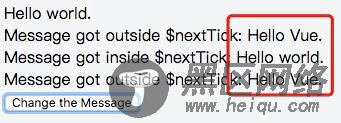Vue中的 nextTick 涉及到Vue中DOM的异步更新,感觉很有意思,特意了解了一下。其中关于 nextTick 的源码涉及到不少知识,很多不太理解,暂且根据自己的一些感悟介绍下 nextTick 。
一、示例
先来一个示例了解下关于Vue中的DOM更新以及 nextTick 的作用。
模板
<div>
<div ref="msgDiv">{{msg}}</div>
<div v-if="msg1">Message got outside $nextTick: {{msg1}}</div>
<div v-if="msg2">Message got inside $nextTick: {{msg2}}</div>
<div v-if="msg3">Message got outside $nextTick: {{msg3}}</div>
<button @click="changeMsg">
Change the Message
</button>
</div>
Vue实例
new Vue({ el: '.app', data: { msg: 'Hello Vue.', msg1: '', msg2: '', msg3: '' }, methods: { changeMsg() { this.msg = "Hello world." this.msg1 = this.$refs.msgDiv.innerHTML this.$nextTick(() => { this.msg2 = this.$refs.msgDiv.innerHTML }) this.msg3 = this.$refs.msgDiv.innerHTML } } })
点击前
点击后

从图中可以得知:msg1和msg3显示的内容还是变换之前的,而msg2显示的内容是变换之后的。其根本原因是因为Vue中DOM更新是异步的(详细解释在后面)。
二、应用场景
下面了解下 nextTick 的主要应用的场景及原因。
在Vue生命周期的 created() 钩子函数进行的DOM操作一定要放在 Vue.nextTick() 的回调函数中
在 created() 钩子函数执行的时候DOM 其实并未进行任何渲染,而此时进行DOM操作无异于徒劳,所以此处一定要将DOM操作的js代码放进 Vue.nextTick() 的回调函数中。与之对应的就是 mounted() 钩子函数,因为该钩子函数执行时所有的DOM挂载和渲染都已完成,此时在该钩子函数中进行任何DOM操作都不会有问题 。
在数据变化后要执行的某个操作,而这个操作需要使用随数据改变而改变的DOM结构的时候,这个操作都应该放进 Vue.nextTick() 的回调函数中。
具体原因在Vue的官方文档中详细解释:
Vue 异步执行 DOM 更新。只要观察到数据变化,Vue 将开启一个队列,并缓冲在同一事件循环中发生的所有数据改变。如果同一个 watcher 被多次触发,只会被推入到队列中一次。这种在缓冲时去除重复数据对于避免不必要的计算和 DOM 操作上非常重要。然后,在下一个的事件循环“tick”中,Vue 刷新队列并执行实际 (已去重的) 工作。Vue 在内部尝试对异步队列使用原生的 Promise.then 和 MessageChannel ,如果执行环境不支持,会采用 setTimeout(fn, 0) 代替。
例如,当你设置 vm.someData = 'new value' ,该组件不会立即重新渲染。当刷新队列时,组件会在事件循环队列清空时的下一个“tick”更新。多数情况我们不需要关心这个过程,但是如果你想在 DOM 状态更新后做点什么,这就可能会有些棘手。虽然 Vue.js 通常鼓励开发人员沿着“数据驱动”的方式思考,避免直接接触 DOM,但是有时我们确实要这么做。为了在数据变化之后等待 Vue 完成更新 DOM ,可以在数据变化之后立即使用 Vue.nextTick(callback) 。这样回调函数在 DOM 更新完成后就会调用。
三、 nextTick 源码浅析
作用
Vue.nextTick 用于延迟执行一段代码,它接受2个参数(回调函数和执行回调函数的上下文环境),如果没有提供回调函数,那么将返回 promise 对象。
源码
/** * Defer a task to execute it asynchronously. */ export const nextTick = (function () { const callbacks = [] let pending = false let timerFunc function nextTickHandler () { pending = false const copies = callbacks.slice(0) callbacks.length = 0 for (let i = 0; i < copies.length; i++) { copies[i]() } } // the nextTick behavior leverages the microtask queue, which can be accessed // via either native Promise.then or MutationObserver. // MutationObserver has wider support, however it is seriously bugged in // UIWebView in iOS >= 9.3.3 when triggered in touch event handlers. It // completely stops working after triggering a few times... so, if native // Promise is available, we will use it: /* istanbul ignore if */ if (typeof Promise !== 'undefined' && isNative(Promise)) { var p = Promise.resolve() var logError = err => { console.error(err) } timerFunc = () => { p.then(nextTickHandler).catch(logError) // in problematic UIWebViews, Promise.then doesn't completely break, but // it can get stuck in a weird state where callbacks are pushed into the // microtask queue but the queue isn't being flushed, until the browser // needs to do some other work, e.g. handle a timer. Therefore we can // "force" the microtask queue to be flushed by adding an empty timer. if (isIOS) setTimeout(noop) } } else if (!isIE && typeof MutationObserver !== 'undefined' && ( isNative(MutationObserver) || // PhantomJS and iOS 7.x MutationObserver.toString() === '[object MutationObserverConstructor]' )) { // use MutationObserver where native Promise is not available, // e.g. PhantomJS, iOS7, Android 4.4 var counter = 1 var observer = new MutationObserver(nextTickHandler) var textNode = document.createTextNode(String(counter)) observer.observe(textNode, { characterData: true }) timerFunc = () => { counter = (counter + 1) % 2 textNode.data = String(counter) } } else { // fallback to setTimeout /* istanbul ignore next */ timerFunc = () => { setTimeout(nextTickHandler, 0) } } return function queueNextTick (cb?: Function, ctx?: Object) { let _resolve callbacks.push(() => { if (cb) { try { cb.call(ctx) } catch (e) { handleError(e, ctx, 'nextTick') } } else if (_resolve) { _resolve(ctx) } }) if (!pending) { pending = true timerFunc() } if (!cb && typeof Promise !== 'undefined') { return new Promise((resolve, reject) => { _resolve = resolve }) } } })()
首先,先了解 nextTick 中定义的三个重要变量。
callbacks
用来存储所有需要执行的回调函数
pending
用来标志是否正在执行回调函数
timerFunc
用来触发执行回调函数
接下来,了解 nextTickHandler() 函数。
function nextTickHandler () { pending = false const copies = callbacks.slice(0) callbacks.length = 0 for (let i = 0; i < copies.length; i++) { copies[i]() } }
这个函数用来执行 callbacks 里存储的所有回调函数。
接下来是将触发方式赋值给 timerFunc 。
先判断是否原生支持promise,如果支持,则利用promise来触发执行回调函数;
否则,如果支持MutationObserver,则实例化一个观察者对象,观察文本节点发生变化时,触发执行所有回调函数。
如果都不支持,则利用setTimeout设置延时为0。
最后是 queueNextTick 函数。因为 nextTick 是一个即时函数,所以 queueNextTick 函数是返回的函数,接受用户传入的参数,用来往callbacks里存入回调函数。

上图是整个执行流程,关键在于 timeFunc() ,该函数起到延迟执行的作用。
从上面的介绍,可以得知 timeFunc() 一共有三种实现方式。
Promise
MutationObserver
setTimeout
其中 Promise 和 setTimeout 很好理解,是一个异步任务,会在同步任务以及更新DOM的异步任务之后回调具体函数。
下面着重介绍一下 MutationObserver 。
MutationObserver 是HTML5中的新API,是个用来监视DOM变动的接口。他能监听一个DOM对象上发生的子节点删除、属性修改、文本内容修改等等。
调用过程很简单,但是有点不太寻常:你需要先给他绑回调:
var mo = new MutationObserver(callback)
通过给 MutationObserver 的构造函数传入一个回调,能得到一个 MutationObserver 实例,这个回调就会在 MutationObserver 实例监听到变动时触发。
